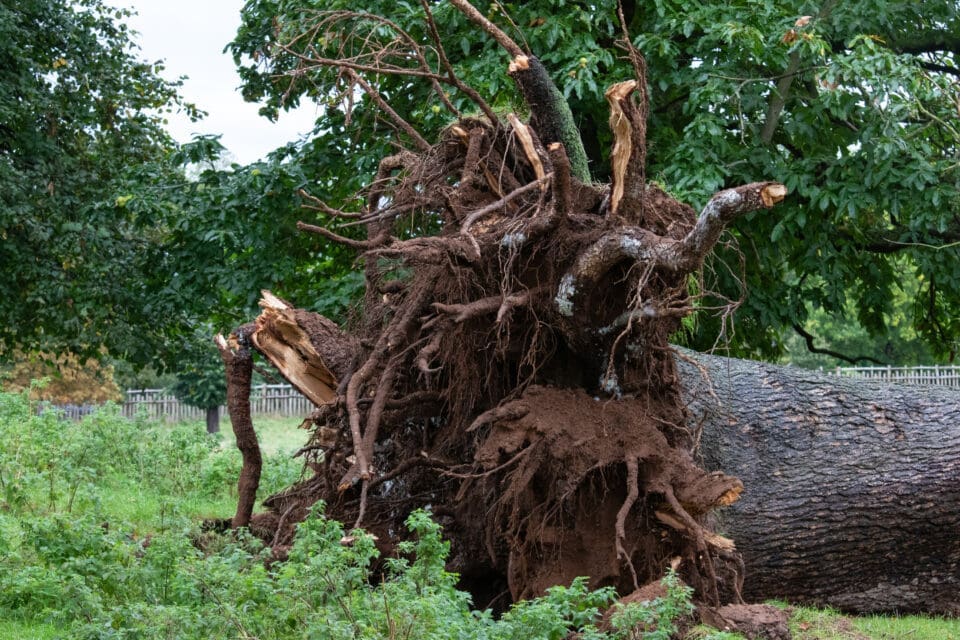Storm Babet’s widespread damage a taste of things to come, says National Trust
- Volume of water temporarily overwhelms hydro at Cragside in Northumberland
- Deluge erodes pathways in the Peak District
- Gardens and parkland waterlogged by swollen rivers, damaging bridges and children’s play areas
- Swift action by collections teams safeguards historic books and significant wallpaper at Hardwick Hall and Belton House
- Centuries-old trees topple, including an 18th-century cedar planted as part of landscape work by ‘Capability’ Brown
- Charity expects damage to amount to thousands, and appeals for donations to help with repair work
Storm Babet has left a trail of destruction across landscapes, houses and gardens cared for by the National Trust, throughout the spine of England.
The persistent rain that fell on Thursday and Friday and continued into the weekend, caused water levels to rise across much of the country, impacting properties in the Midlands and North East of England, said the conservation charity.
The full extent of the damage is still being assessed today (Tuesday), but the costs of repairs, could amount to tens of thousands of pounds.
Harry Bowell, Head of Land and Nature said: “We know that one of the consequences of climate change will be the frequency of more extreme weather events, and we experienced the direct impact of the prolonged levels of rainfall and high winds on our places last week.
“We recognise we need to adapt our places to cope with the likelihood of these extreme weather events – and we are already doing that through establishing trees and woodlands, restoring peatlands to hold more water in our landscapes, particularly upland areas – and through our work to re-connect rivers with their floodplains to create new areas of wetland to again help hold the water back in times of heavy and persistent rainfall.
“It is now more important than ever that we play our part to adapt to our changing weather patterns as well as implementing more measures to tackle climate change. But we also need more urgent and wide-ranging investment and action to address these issues by governments and leaders across the country.”
At the world-famous Cragside in Northumberland, the first house in the world to be powered by hydro-electricity, relentless rain fell onto the two sides of the Coquet valley. Over a 48-hour period at the end of last week, water flowed down the hillsides into the lakes on the grounds and surrounding area causing water levels in the River Coquet to rise from its usual 0.4 metres to 3.27 metres [1].
Ironically, engineers also believe that rising water levels and sheer volume of water overwhelmed the Archimedes Screw, causing it to temporarily stop working. It was installed in 2014 to generate hydro-electricity to light Cragside House, and to help with the National Trust’s renewable energy commitment to reduce its reliance on fossil fuels and reach net zero by 2030.
John O’Brien, General Manager at Cragside said: “It’s been years since I’ve seen water levels like this at Cragside. The lakes were exceptionally full and water was moving rapidly along Debdon Burn that passes under the Iron Bridge. With the extra rainfall, water thundered through the Gorge at a pace creating a dramatic waterfall. When the water met the already overflowing River Coquet, it backed up and flooded the historic hydroelectric Powerhouse, partially submerging some of the original, Victorian dynamos and turbines in silty water.”
In the Peak District a deluge of water rushed down the hillsides and overpowered river networks causing flooding and eroding hundreds of metres footpaths and damaging fences, walls and bridges.
Since Friday, the team at Longshaw has already spent more than 82 hours of work to complete just half of the work needed to repair the damage that has been identified so far, but there is still more to do. As well as repairs, work has also started to explore ways to build more resilient infrastructure to cope with future weather conditions.
Craig Best, General Manager in the Peak District said: “I was among many people in the Peak District and surrounding towns and villages who had a very frightening drive home on Friday. The chaos and devastation the storm caused to homes, businesses, roads and transport systems in the area is truly shocking. It certainly brings it home how vulnerable we are to extreme weather events like this when you see it unfold. Let’s not forget though, in good condition the uplands of the Peak District can hold the key to reducing the impact of extreme weather conditions like this. They could be our first line of defence.
“If we restore peatlands, plant and allow the natural regeneration of more trees, and improve soil health here we can help to store and slow the flow of water into our rivers, streams and reservoirs. We’ve started this work, with partners and tenants, but we need to do more and faster. We need to ensure the importance of restoring our uplands, for nature and for people, is recognised, and secure investment to carry out the work needed.”
At Carding Mill Valley and the Long Mynd in Shropshire, the volume of water was such, it has eroded away some of banks of the Ashbrooke river – more commonly referred to as a stream – that flows through the valley.
The damage to the riverbank is being monitored as some cracks have appeared. The flooding has also resulted in the transportation of lots of rocks from higher up the valley, which have been carried downstream.
At Kedleston Hall in Derbyshire, home to an 18th-century Pleasure Ground and 800-acre, wildlife-rich parkland, the storm caused structural damage to a wooden footbridge on the lakeside walk and washed away bench seats.
On the Wallington Estate in Northumberland, 93.9mm of rain fell on Thursday and Friday [2] causing the River Wansbeck to spill over onto the River Walk causing both bank and path erosion.
The rainfall also caused a tributary to the river to swell to very high levels with concerns that it could potentially damage the beaver enclosure, home to a family of beavers released in July. However, thankfully the team has since assessed the site and seen signs of beaver activity within the enclosure.
Fortunately, recent dam works on the garden pond just outside the walled garden meant it was able to withstand the storm deluge, protecting the walled garden and its retaining wall. However, high winds blew a stone ball off one of its garden gates and toppled a veteran sessile oak tree (planted c1750) in the East Woods across the path into the pond, temporarily blocking access to the walled garden.
A substance was also reportedly washed up on beaches at Low Newton, Embleton and Long Nanny on the Northumberland Coast. Samples have been sent away for testing as it’s thought the substance could pose a risk to dogs.

At Charlecote Park in Warwickshire, a 260-year old Cedar of Lebanon came down in the deer park, probably due to the weight of water brought by Storm Babet. The tree is thought to have been planted in the 1760s as part of improvements made by ‘Capability’ Brown. Large areas of the parkland are now closed or inaccessible due to flooding, storm damage and waterlogged ground.
And, at Hardwick Hall in Derbyshire, the team reacted quickly to move the 300-strong book collection in the Long Gallery due to the rain leaking through the east side windows – with the collections sitting directly underneath. There was no damage to the books. The collection here includes books from the library of pioneering scientist Henry Cavendish (1731-1810), who calculated the density of the earth, and Hardwick’s oldest volume, a 1549 book illustrated with woodcuts of early ships by a French diplomat and poet.
At Belton House in Lincolnshire, the sheer volume of rainfall overwhelmed guttering and water leaked into a number of windows, including the Chinese Bedroom, which is lined with highly significant handpainted wallpaper hung in 1830. Staff used padding to soak up water trickling down the paper and used a dehumidifier to prevent mould developing. Fortunately, no staining is visible and the historic adhesive is intact, but its condition will be closely monitored by conservators.
The River Witham also burst its banks, causing significant flooding in the pleasure grounds and children’s playground which is now under repair.
Andy Jasper, Director of Gardens and Parklands at the National Trust, said: “Our garden teams are doing an amazing job, working hard to repair and reinstate damaged areas and we are so grateful for their efforts in such difficult conditions. Some visitors may not be able to visit parts of their favourite gardens or parkland while we do this work and we thank them for their patience, too.
“These extreme weather events are likely to become more frequent as a sign of the rapidly changing climate. With more than 220 gardens and parklands across the National Trust, we are doing everything we can to make these historic gardens as future-proof as possible. This includes thinking longer term for extremes of heat, choosing more drought tolerant plants, creating path surfaces that are more resilient and caring for our lawns and soil so they are less prone to waterlogging. These are just some of the many steps we are taking which will help our gardens thrive into the future. All of this underlines just how important people’s support to our charity is – the costs of adapting the places we look after to extreme weather events are only going to increase.”
The clear-up operation is likely to take several weeks and could be hampered by further rain which is forecast for later this week.
The Trust is advising visitors to sites in the Midlands and north of England to check property websites before setting out as some areas may be closed for repairs.
Donations to help towards the clear up work and ongoing conservation work to protect National Trust places from the impacts of climate change can be made via the National Trust website: //nationaltrust.org.uk/donate





